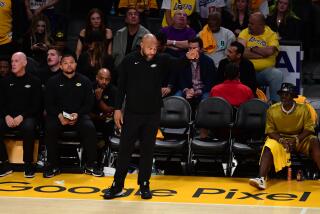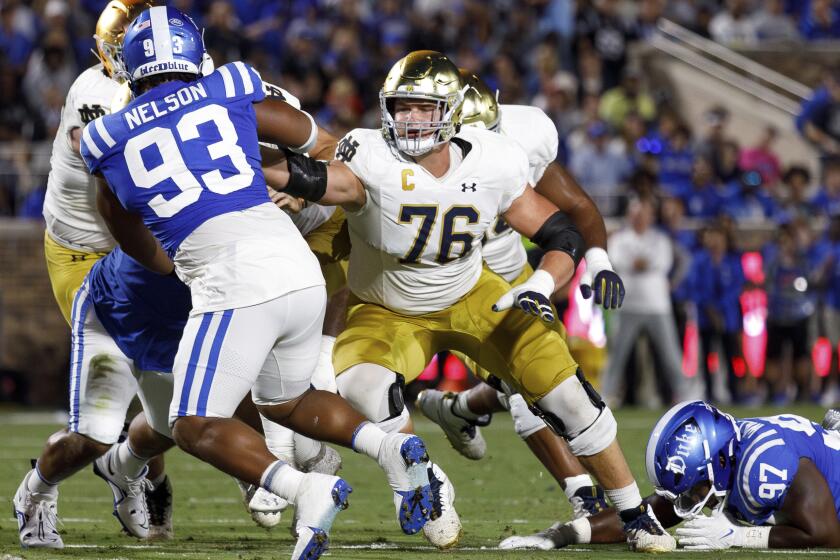Joe Foss, 87; Ace Won Medal of Honor, Was Governor and Football Executive
Joe Foss, a World War II Medal of Honor-winning fighter pilot who served as governor of South Dakota and became the influential first commissioner of the old American Football League, has died. He was 87.
Foss, whose war-hero status never faded, died Wednesday. He had been in a Scottsdale, Ariz., nursing facility after suffering a stroke in October.
As a Marine Corps pilot based on Guadalcanal, the former South Dakota farm boy shot down 26 enemy planes from October 1942 to January 1943, becoming the first pilot to match the record of World War I ace Eddie Rickenbacker.
Called “the American ace of aces” by newscaster Lowell Thomas, Foss received the Medal of Honor “for aerial combat achievement unsurpassed in this war” from President Franklin D. Roosevelt in a White House ceremony in 1943.
He appeared on the cover of Life magazine, toured the nation making personal appearances and later received a Hollywood offer to have John Wayne portray him on film.
But World War II was only the beginning of public life for the cigar-chewing, seemingly fearless Foss.
After the war, Foss, a Republican, served two terms in the South Dakota Legislature and, beginning in 1955, four years as governor.
In 1959 -- after losing a run for the U.S. House of Representatives to another South Dakota war-hero pilot, George McGovern -- Foss became the first commissioner of the new American Football League, overseeing the bumpy beginnings of the upstart rival of the firmly entrenched National Football League.
Over the next six years, Foss played a key role in launching the AFL’s eight original teams, including the Houston Oilers, Denver Broncos and Buffalo Bills.
During that time, the AFL took the lead in changing the way football was presented on television.
It avoided the NFL practice of using two clocks -- one for the crowd and one for the officials. The game clock became the AFL’s official timepiece, which allowed the audience to follow the play accurately with the knowledge that the time remaining on the clock was the actual time left.
The AFL also adopted the practice of printing players’ names on their jerseys. And unlike the NFL, which limited television coverage to the plays and noncontroversial action between plays, Foss allowed ABC-TV to cover personal disagreements and other heated between-play action.
He also gave reporters immediate post-game access to locker rooms rather than making them wait through the players’ standard “cooling off” period of as much as an hour before interviewing them.
Foss resigned as AFL commissioner in April 1966, two months before the AFL and NFL agreed to form a combined league of 24 teams under the National Football League title in 1970.
An avid hunter and fisherman, Foss hosted ABC-TV’s “The American Sportsman” from 1964 to 1967, and produced and hosted the syndicated TV series “The Outdoorsman: Joe Foss” from 1967 to 1974.
A staunch member of the National Rifle Assn., he served as NRA president from 1988 to 1990, proudly appearing on the cover of Time magazine wearing a black Stetson and clutching a six-gun to his chest.
By then a retired Air National Guard brigadier general, he remained a man of unyielding convictions, telling Time: “I say all guns are good guns. There are no bad guns. I say the whole nation should be an armed nation. Period.”
In 2001, Foss established the Foss Institute, a Scottsdale-based nonprofit organization designed to build an understanding of freedom, its cost and patriotism in school-age children.
This month the institute will begin sending volunteer combat veterans into schools, where they will speak and show a videotape chronicling the life of its iconic founder.
“I come from a military family, and he was the concept of what an American could be,” said actor Robert Stack, a hunting buddy of Foss who joined him on an African safari for the first segment of “The American Sportsman.”
“He had a great love of country, a pride in being an American,” said Stack. “To put it simply, Joe was my hero.”
“He was truly a great man,” said NBC News anchorman Tom Brokaw, who became a friend of Foss in the mid-1950s and wrote about him in his best-selling book on World War II veterans: “The Greatest Generation.”
As the charismatic governor of South Dakota, Foss was, Brokaw said, “emblematic of that generation in terms of how hard he had it as a kid and how selfless he was as a warrior and how, when he returned after all those difficult years, he just went into public service.”
Born on a farm near Sioux Falls, S.D., on April 17, 1915, Foss grew up in a farmhouse that lacked electricity and was heated only by a potbellied stove in the living room.
His father taught him to hunt as a boy, and they both shared a passion for the airplanes they spotted flying high above their farm.
When Foss was 12, his father took him to the local airfield to see the touring Charles Lindbergh and the pilot’s Spirit of St. Louis soon after Lindbergh made his historic flight to Paris in 1927. Four years later, Foss and his father paid $1.50 apiece to take their first airplane ride.
On a stormy night in 1933, when Foss was in his senior year of high school, he discovered the body of his father, who had been electrocuted by a downed power line while driving home from the fields.
The 18-year-old Foss took over the family farm, whose stock and crops were destroyed by dust storms that struck over the next two years.
At his mother’s insistence, he continued his education. He worked at a gas station and took odd jobs to pay for his books, college tuition and flight lessons.
Foss already had his pilot’s license in 1940 when he graduated with a degree in business administration from the University of South Dakota and enlisted in the Marines’ aviation program. He earned his wings in March 1941.
After serving as a flight instructor at Pensacola, Fla., he shipped out for Guadalcanal in late August 1942 as the executive officer of a squadron of Marine F-4 Wildcat fighter planes.
Foss’ unit became known as the Flying Circus.
He downed his first Japanese Zero on Oct. 13, but his own plane was hit and he barely escaped becoming a casualty himself.
With a dead engine -- and three Zeroes on his tail -- he managed to land at full speed, with no flaps and minimal control, on the American runway on Guadalcanal. He narrowly missed plowing into a grove of palm trees.
On another mission, as it’s told in the Brokaw book, Foss deliberately dove at a Japanese battleship to draw fire and make it easier for other U.S. planes to torpedo it.
Another time, after downing three enemy planes, he was forced to ditch his own disabled aircraft in the sea. After several hours of swimming, he was rescued by island natives in a dugout canoe.
By the time he left Guadalcanal in January 1943, Foss’ Flying Circus had shot down 72 Japanese planes, including the 26 credited to him.
After the war, he returned to Sioux Falls, capitalizing on his name recognition by opening the Joe Foss Flying Service, which offered charter flights and flying instruction. He later started the Foss Motor Co., a Sioux Falls Studebaker and Packard dealership.
He also organized the South Dakota Air National Guard and commanded the Guard’s 175th Flight Squadron. During the Korean War, he served with the Air Force as a colonel directing training.
While governor, Foss came out to Hollywood to meet with producer Hal Bartlett and John Wayne.
As recounted in “The Greatest Generation,” Foss had been offered $750,000 for the screen rights to his story and John Wayne was to receive $1 million to portray him.
Flanked by Wayne and Bartlett in a booth in the Polo Lounge at the Beverly Hills Hotel, Foss was asked what he thought of the script.
“Fine -- except for that romance baloney,” he replied. “If you’re going to do a story on Joe Foss, you gotta take that out.”
When told that the contrived love story was necessary to make the movie appealing, Foss turned them down.
“That wasn’t me at all,” he told Brokaw.
Brokaw told The Times that Foss later found Christianity, which became “a defining part of his life.”
For many years, he spoke on behalf of Campus Crusade for Christ International, with which he and his second wife Donna, whom he nicknamed Didi, had been associated since 1975.
More to Read
Get our high school sports newsletter
Prep Rally is devoted to the SoCal high school sports experience, bringing you scores, stories and a behind-the-scenes look at what makes prep sports so popular.
You may occasionally receive promotional content from the Los Angeles Times.






